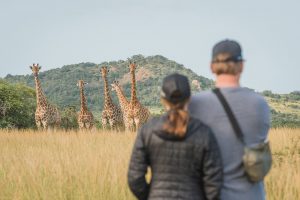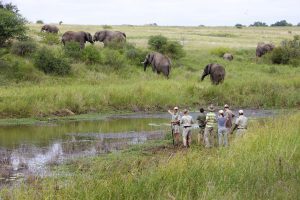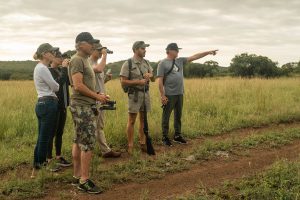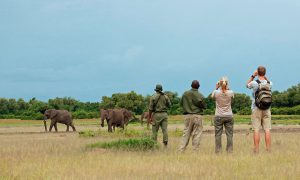Exploring the African bush in a 4×4 safari vehicle allows you to see tons of wildlife on your game drives, but traversing on foot gives you an intimate look at the world around you. Walking safaris aren’t necessarily intended for crossing the Big 5 off your viewing checklist, or to bring you face to face with animals – but rather to help you understand your natural surroundings in a more thoughtful way.
Understandably so, it can be intimidating to picture yourself walking through wild Africa without the protection of a jeep, but we’re here to explain how walking safaris can be an incredibly safe and immersive way to enjoy Africa.
A Typical Day on Safari

An average day at a safari lodge follows a similar schedule, starting with an early morning wake up (with delicious snacks and coffee to hold you over until breakfast), a morning game drive for 3-4 hours and then a return to camp for a full breakfast feast at the lodge – or perhaps a surprise bush breakfast. Game drives are scheduled for the early morning and late afternoon when the weather is a bit cooler and wildlife tends to be more active. This gives you a better chance of seeing animals on the go, and perhaps even capturing a photo of predators hunting, compared to finding a pride of sleeping lions escaping the heat during the middle of the day (but who are we kidding, lions are lazy and can be found sleeping at any point of the day).
After lunch and some time relaxing at the lodge, you’re off on your evening game drive for another 3-4 hours. Around sunset, you will generally stop for a ‘sundowner’ at a scenic spot, allowing you to get out of the vehicle and enjoy the natural surroundings on foot. After you’ve had your fill of biltong and gin and tonics, you’ll be back in the vehicle for more game viewing as you return to the lodge just after dark. Dinner at the lodge and bedtime as you please, before you repeat this schedule the following morning.
Why a Walking Safari?

With traditional safari game drives, you will spend most of your time observing wildlife from above – moving between exciting sightings and tracking animals on the hunt, bringing you action-packed game viewing experiences. If you’re seeking an additional thrill, you may want to ditch the jeep for an afternoon and walk among the wildlife for a change. There’s nothing quite like the slight increase in adrenaline when you hear a rustle in the nearby brush (even if it is just a springhare crossing through)! Pairing a walking safari with traditional game drives is the perfect way to discover all there is to see and learn about Africa’s fantastic flora and fauna.
In addition to seeing big game while on foot, walking safaris allow you to see and hear some of the things you may not otherwise notice on a game drive. For example, the call of a lilac-breasted roller (or many other birds endemic to Africa) is something you might miss over the sound of the moving vehicle. It is such a treat being able to hear animals calling to one another, communicating if there is a predator near – or announcing your presence to surrounding animals. Insects chirping and wind rushing through the tall grasses are the typical soundtrack to a walking safari and boy, are they beautiful!
For those looking to really unplug, a walk on the wild side is a great way to switch off the outside world and connect with nature. You’ll be fully invested in the sounds and smells of the bush, not worrying about your phone or incoming emails.
Additionally, walking safaris are a great way to get a little extra exercise during your time in Africa. Walking safaris can range from quick 1-2 hour walks, or can be longer escapades that take place over multiple days. In some parks, you can even opt out of the vehicle transfer and travel between lodges by foot! After your excursion in the bush, you’ll arrive at your destination and all your luggage will be waiting for you at your next “home”.
Unique Perspective
![]()
Some of the highlights of a walking safari are seeing the details and smaller critters that are easily missed while zooming around on a vehicle. Specialized walking safari guides are taught to identify the little things that go unnoticed, such as signs telling if animals have been nearby or if they are distressed. Just from looking at a broken branch of a tree or by stumbling across some fresh tracks, specially trained walking safari guides can recognize which animals may have been passing through and how long ago.
Droppings, animal remains, fascinating insects, and plant life are all unique elements of walking safaris, as well as gaining an understanding of the way a particular ecosystem operates. Well educated guides are often able to tell a detailed story just by looking at a pile of bones.
Walking Safaris Are Safe

We always recommend working with reputable safari operators that prioritize guide education and training to ensure that your walking safari will be a very safe and enjoyable experience. In order to lead a walking safari, rangers must first go through additional intensive training and multiple certifications, so that they are fully equipped to handle tricky situations in the wild. A few guidelines that your qualified guide will share with you for before your first walking safari may include:
- The best time of day for walking safaris. You’ll want to try to plan your excursion when most animals are sleeping after a long night of hunting, or before they wake to hunt again. Picking the right time of day for your adventure also helps to combat heat, which can be quite draining.
- Correct attire is important to keep you comfortable and to help you blend in with your surroundings. High-ankle and supportive hiking boots are key, as is wearing muted neutral colored clothing and sun protection.
- It is best to walk in a single-file line with a safari guide in both the front and back, to be sure you’ve got the most experienced eyes and ears surrounding the group, looking out for exciting viewing opportunities. At the very front of the line, it is recommended to have an armed guard or tracker for an additional layer of safety.
- Keeping voices low without excess chatter can prevent animals from startling, and helps to preserve the stillness and calm of the wild around you.
- ALWAYS follow the instructions of your trackers and guides, as they are highly experienced in reading their surroundings for potential dangers.
Best Locations for Walking Safaris

There are a handful of destinations within Africa that are perfectly suited for walking safaris, with the best scenery, wildlife, and safety in mind.
The first country that comes to mind is Zambia, as it is widely considered to be the “birthplace of the walking safari”. South Luangwa, North Luangwa, and Kafue National Parks all offer tremendous, off the beaten path, experiences. Rich with wildlife, the paths along the Zambezi and Luangwa Rivers are special places for viewing huge herds of elephants and spectacular landscapes. Some lucky visitors may even get the chance to view cats or African wild dogs from a safe distance while on foot.
Ruaha and Selous National Parks in Tanzania also offer great terrain for walking safaris, including beautiful mountains, rock formations and grasslands scattered with mighty and iconic baobab trees. Samburu National Park in Kenya is excellent for longer walking safaris, specifically for guests with higher fitness levels since the terrain is a bit more uneven than other regions. Fantastic scenery and concentrated wildlife near the Ewaso Nyiro River make this a great spot for short or multi-day walking safaris.
Trekking to see Mountain Gorillas in Rwanda’s Volcanoes National Park is technically considered to be a walking safari, and should absolutely be at the top of every traveler’s bucket list. The steep climb through the thick and lush rainforests is the perfect lead up before coming face to face with these magnificent primates.
See You In the Wild
Escaping the confines of your 4×4 jeep and exploring the wilderness on foot opens up an entirely new world to be discovered. When dreaming up your next adventure in Africa, we recommend spending a day (or more) adventuring on foot to get a true taste of what it means to be in the wild.
Interested?
Related Posts



Start Planning Your Dream Trip
Reach out and let’s start talking. We’ll listen and begin to tailor an experiential, private, luxury vacation based on exactly how you want to experience Africa. From adventure to relaxation—and everything in between—let us handle every detail of your unforgettable journey.



